Preparation of UV-Curable Nano-WO3Coating and Its Infrared Shielding Properties
Abstract
1. Introduction
2. Experimental Section
2.1. Materials and Instruments
2.2. Preparation of Nano-WO3Dispersion
2.3. Preparation of Light Curing Coatings
2.4. Characterization
2.4.1. Particle Size Analysis
2.4.2. Infrared Spectrum Analysis
2.4.3. Field Emission Scanning Electron Microscope (SEM)
2.4.4. X-ray Diffraction (XRD)
2.4.5. Thermogravimetric Analysis (TGA)
2.4.6. Haze Analysis
2.4.7. Absorbance Analysis
3. Results and Discussion
3.1. Effect of Grinding Time on Particle Size of Nano-WO3
3.2. Effects of the Amount of Dispersant
3.3. Effects of Solvent on the Dispersion of Nano-WO3
3.4. Particle Size Distribution of Nano-WO3Dispersion
3.5. FT-IR Testing of Composite Coatings
3.6. Morphology Analysis of Composite Coatings
3.7. XRD Analysis of Composite Coating
3.8. Thermal Stability Analysis of Composite Coatings
3.9. Haze and Mechanical Properties of Composite Coatings
3.10. Optical Properties of Cured Coating
4. Conclusions
Author Contributions
Funding
Institutional Review Board Statement
Informed Consent Statement
Data Availability Statement
Acknowledgments
Conflicts of Interest
References
- Zhang, H.; Liu, J.; Shi, F.; Jiang, S.; Song, X.; Wasim, M.; Song, X.; Ma, J. Controlling the growth of hexagonal CsxWO3 nanorods by Li+-doping to further improve its near infrared shielding performance. Sol. Energy Mater. Sol. Cells 2022, 238, 111612. [Google Scholar] [CrossRef]
- Yang, C.; Chen, J.-F.; Zeng, X.; Cheng, D.; Cao, D. Design of the Alkali-Metal-Doped WO3 as a Near-Infrared Shielding Material for Smart Window. Ind. Eng. Chem. Res. 2014, 53, 17981–17988. [Google Scholar] [CrossRef]
- Lin, C.H.; Lee, G.B.; Lin, Y.H.; Chang, J. A fast prototyping process for fabrication of microfluidic systems on soda-lime glass. J. Micromech.Microeng. 2001, 11, 726–732. [Google Scholar] [CrossRef]
- Mirsayar, M.; Joneidi, V.; Petrescu, R.; Petrescu, F.; Berto, F. Extended MTSN criterion for fracture analysis of soda lime glass. Eng. Fract. Mech. 2017, 178, 50–59. [Google Scholar] [CrossRef]
- Maiorov, V. Light-Transparent Infrared Filters with Dispersed Plasmonic Nanoparticles. Glass Phys. Chem. 2020, 46, 203–217. [Google Scholar] [CrossRef]
- Nair, A.-S.; Keerthana, C.S.; Abraham, J.-E.; Jeorge, P.; Biju, P.R.; Unniklishnan, N.V. Effect of substrate temperature on the near-infrared shielding properties of WO3-X thin films deposited by RF magnetron sputtering. Vacuum 2022, 202, 111143. [Google Scholar] [CrossRef]
- Alzahran, J.S.; Lebedev, A.V.; Avanesov, S.A.; Hammoud, A.; Alrowaili, Z.A.; Mahmoud, Z.M.M.; Olarinoye, I.O.; Sriwunkum, C.; Al-Buriahi, M.S. Synthesis, optical properties and radiation shielding performance of TeO2-Na2O-BaO-WO3 glass system. Optiks 2022, 261, 169167. [Google Scholar] [CrossRef]
- Nguyen, T.K.N.; Adèle, R.; Maxence, W.; Dumait, N.; Paofai, S.; D Benjamin, D.; Whnagwui, C.; Ohashi, N.; Cordier, S.; Grasset, F. New ultra-violet and near-infrared blocking filters for energy saving applications: Fabrication of tantalum metal atom cluster-based nanocomposite thin films by electrophoretic deposition. J. Mater. Chem. C Mater. Opt. Electron. Devices 2017, 5, 10477–10484. [Google Scholar] [CrossRef]
- Shen, B.; Wang, Y.; Lu, L.; Yang, H. Spraying fabrication of spectrally selective coating with improved near-infrared shielding performance for energy-efficient glazing. Ceram. Int. 2021, 47, 18991–18997. [Google Scholar] [CrossRef]
- Assadullah, I.; Bhat, A.A.; Malik, J.H.; Malik, K.A.; Tomar, R.; Khandy, S.A. Electronic structure, optical, photocatalytic and charge storage performance of WO3 nanostructures. J. Phys. Chem. Solids 2022, 165, 110649. [Google Scholar] [CrossRef]
- Du, W.-C.; Xie, J.; Xia, L.; Liu, Y.; Zhang, Y. Study of new solar film based on near-infrared shielding. J. Photochem. Photobiol. A Chem. 2021, 418, 113410. [Google Scholar] [CrossRef]
- Jiang, S.; Miao, D.; Xu, J.; Shang, S.; Ning, X.; Zhu, P. Preparation and characterization of shielding textiles to prevent infrared penetration with Ag thin films. J. Mater. Sci. Mater. Electron. 2016, 28, 3542–3547. [Google Scholar] [CrossRef]
- Wang, M.; Xu, Y.; Liu, Y.; Wu, W.; Xu, S. Synthesis of Sb-doped SnO2 (ATO) hollow microspheres and its application in photo-thermal shielding coating. Prog. Org. Coat. 2019, 136, 105229. [Google Scholar] [CrossRef]
- Zhang, Z.; Zhang, R.; Xu, L.; Li, J.; Yang, L.; Bolshakov, A.; Zhu, J. Visible and infrared optical modulation of PSLC smart films doped with ATO nanoparticles. Dalton Trans. 2021, 50, 10033–10040. [Google Scholar] [CrossRef] [PubMed]
- Wilkins, R.W.T.; Ito, J. Infrared spectra of some synthetic talcs. Am. Mineral. 1967, 52, 1649–1661. [Google Scholar]
- Shen, B.; Wang, Y.; Lin, L.; Yang, H. Synthesis and characterization of Sb-doped SnO2 with high near-infrared shielding property for energy-efficient windows by a facile dual-titration co-precipitation method. Ceram. Int. 2020, 46, 18518–18525. [Google Scholar] [CrossRef]
- Khan, A.F.; ul Abadeen, Z.; Hanif, M.B.; Saleem, M.S.; Naveed, K.; Bashir, K.; Ahmad, I. Multi-layer MgF2/ITO coatings for electromagnetic interference shielding. Mater. Chem. Phys. 2021, 272, 125009. [Google Scholar] [CrossRef]
- Chao, L.; Bao, L.; Wei, W.; Tegus, O. A review of recent advances in synthesis, characterization and NIR shielding property of nanocrystalline rare-earth hexaborides and tungsten bronzes. Sol. Energy 2019, 190, 10–27. [Google Scholar] [CrossRef]
- Zeng, X.; Zhou, Y.; Ji, S.; Lou, H.; Yao, H.; Huang, X.; Jin, P. The preparation of a high performance near-infrared shielding CsxWO3/SiO2 composite resin coating and research on its optical stability under ultraviolet illumination. J. Mater. Chem. C Mater. Opt. Electron. Devices 2015, 3, 8050–8060. [Google Scholar] [CrossRef]
- Gao, H.; Liang, Y.; Li, R.; Huang, H.; Peng, W. Eye-Friendly Reflective Structural Colors with Shortwave Infrared Shielding. Adv. Opt. Mater. 2022, 10, 2101342. [Google Scholar] [CrossRef]
- Gateau, T.; Ayaz, H.; Dehais, F. In silico vs. Over the Clouds: On-the-Fly Mental State Estimation of Aircraft Pilots, Using a Functional Near Infrared Spectroscopy Based Passive-BCI. Front. Hum. Neurosci. 2018, 12, 187. [Google Scholar] [CrossRef]
- Fayad, A.M.; Ouis, M.A.; Batal, F.H.; Eibatal, H.A. Shielding Behavior of Gamma-Irradiated MoO3 or WO3-Doped Lead Phosphate Glasses Assessed by Optical and FT Infrared Absorption Spectral Measurements. Silicon 2017, 10, 1873–1879. [Google Scholar] [CrossRef]
- Ren, Y.; Zhou, X.; Wang, Q.; Zhao, Y. Combined redox and plasmonic electrochromic effects in WO3/ITO double-layer films. J. Sol-Gel Sci. Technol. 2018, 85, 732–742. [Google Scholar] [CrossRef]
- Guo, C.; Yin, S.; Zhang, P.; Yan, M.; Adachi, K.; Chonan, T.; Sato, T. Novel synthesis of homogenous CsxWO3 nanorods with excellent NIR shielding properties by a water controlled-release solvothermal process. J. Mater. Chem. 2010, 20, 8227–8229. [Google Scholar] [CrossRef]
- Li, C.; Kang, C.; Huang, S.; Lee, P.; Kuo, H.; Hsu, F. Near infrared radiation shielding using CsxWO3 nanoparticles for infrared mini light-emitting diodes. Mater. Lett. 2020, 260, 126961. [Google Scholar] [CrossRef]
- Zali, V.S.; Jahanbakhsh, O.; Ahadzadeh, I. Preparation and evaluation of gamma shielding properties of silicon-based composites doped with WO3 micro- and nanoparticles. Radia. Phy. Chem. 2022, 197, 110–152. [Google Scholar] [CrossRef]
- Zhou, Y.; Huang, A.; Zhou, H.; Ji, S.; Jin, P. Organic-Inorganic hybrid optical foils with strong visible reflection, excellent near infrared-shielding ability and high transparency. Nanotechnology 2018, 29, 95705. [Google Scholar] [CrossRef]
- Fernandes, G.E.; Lee, D.; Kim, J.; Kim, K.; Xu, J. Infrared and microwave shielding of transparent Al-doped ZnO superlattice grown via atomic layer deposition. J. Mater. Sci. 2013, 48, 2536–2542. [Google Scholar] [CrossRef]
- Li, T.; Liu, J.; Shi, F.; Song, X.; Zhang, H.; Zhang, H.; Ma, C.; Zhu, K.; Liu, Y. Construction of a novel highly porous BiOBr/CsxWO3@SiO2 composite aerogel: Adsorption/self-heating photocatalytic synergistic degradation of antibiotics and mechanism study. J. Environ. Chem. Eng. 2022, 10, 107785. [Google Scholar] [CrossRef]
- Liu, J.; Ran, S.; Fan, C.; Qiao, Y.; Shi, F.; Yang, J.; Chen, B.; Liu, S. One pot synthesis of Pt-doped CsxWO3 with improved near infrared shielding for energy-saving film applications. Sol. Energy 2019, 178, 17–24. [Google Scholar] [CrossRef]
- Song, X.; Liu, J.; Shi, F.; Fan, C.; Ran, S.; Zhang, H.; Zou, Z. Facile fabrication of KmCsnWO3 with greatly improved near-infrared shielding efficiency based on W5+-induced small polaron and local surface plasmon resonance (LSPR) modulation. Sol. Energy Mater. Sol. Cells 2020, 218, 110769. [Google Scholar] [CrossRef]
- Ghamdi, H.A.; Elsafi, M.; Sayyed, M.I.; Almuqrin, A.H.; Tamayo, P. Performance of newly developed concretesincorporating WO3 and barite as radiation shielding material. JMR T 2022, 19, 4103–4114. [Google Scholar]
- Li, X.; Zhu, L.; Peng, H.; Chen, L.; Liu, X. Synthesis of organic and inorganic hybrid nanoparticles as multifunctional photoinitiator and its application in UV-curable epoxy acrylate-based coating systems. Prog. Org. Coat. 2020, 141, 105565. [Google Scholar] [CrossRef]
- Nguyen, T.V.; Dao, P.; Duong, K.; Le, T.; Dao, P.; Duong, H.; Mac, V.P.; Nguyen, A.M. Effect of R-TiO2 and ZnO nanoparticles on the UV-shielding efficiency of water-borne acrylic coating. Prog. Org. Coat. 2017, 110, 114–121. [Google Scholar] [CrossRef]
- Wang, C.; Zhang, J.; Chen, J.; Shi, J.; Zhao, Y.; He, M.; Ding, L. Bio-Polyols based waterborne polyurethane coatings reinforced with chitosan-modified ZnO nanoparticles. Int. J. Biol. Macromol. 2022, 208, 97–104. [Google Scholar] [CrossRef]
- Dao, P.; Nguyen, T.D.; Nguyen, T.C.; Nguyen, A.H.; Mac, V.P.; Tran, H.T.; Phung, T.L.; Vu, Q.T.; Vu, D.H.; Ngo, T.C. Assessment of some characteristics, properties of a novel waterborne acrylic coating incorporated TiO2 nanoparticles modified with silane coupling agent and Ag/Zn zeolite. Prog. Org. Coat. 2022, 163, 106641. [Google Scholar] [CrossRef]
- Habib, S.; Amani, H.; Ramazan, K.; Ahmed, E.M.; Shakoor, R.A. Self-Healing behavior of epoxy-based double-layer nanocomposite coatings modified with Zirconia nanoparticles. Mater. Des. 2021, 207, 109839. [Google Scholar] [CrossRef]
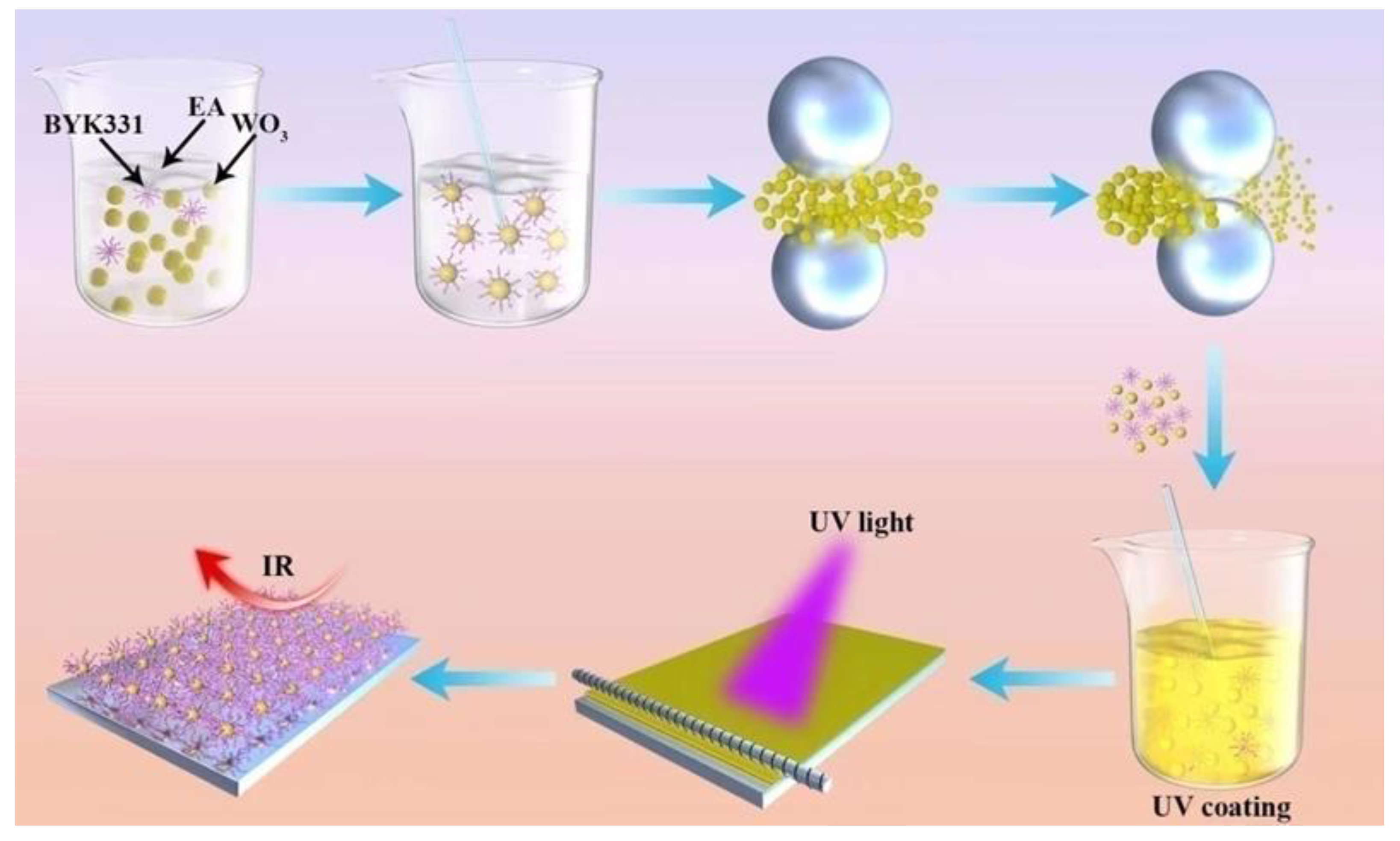
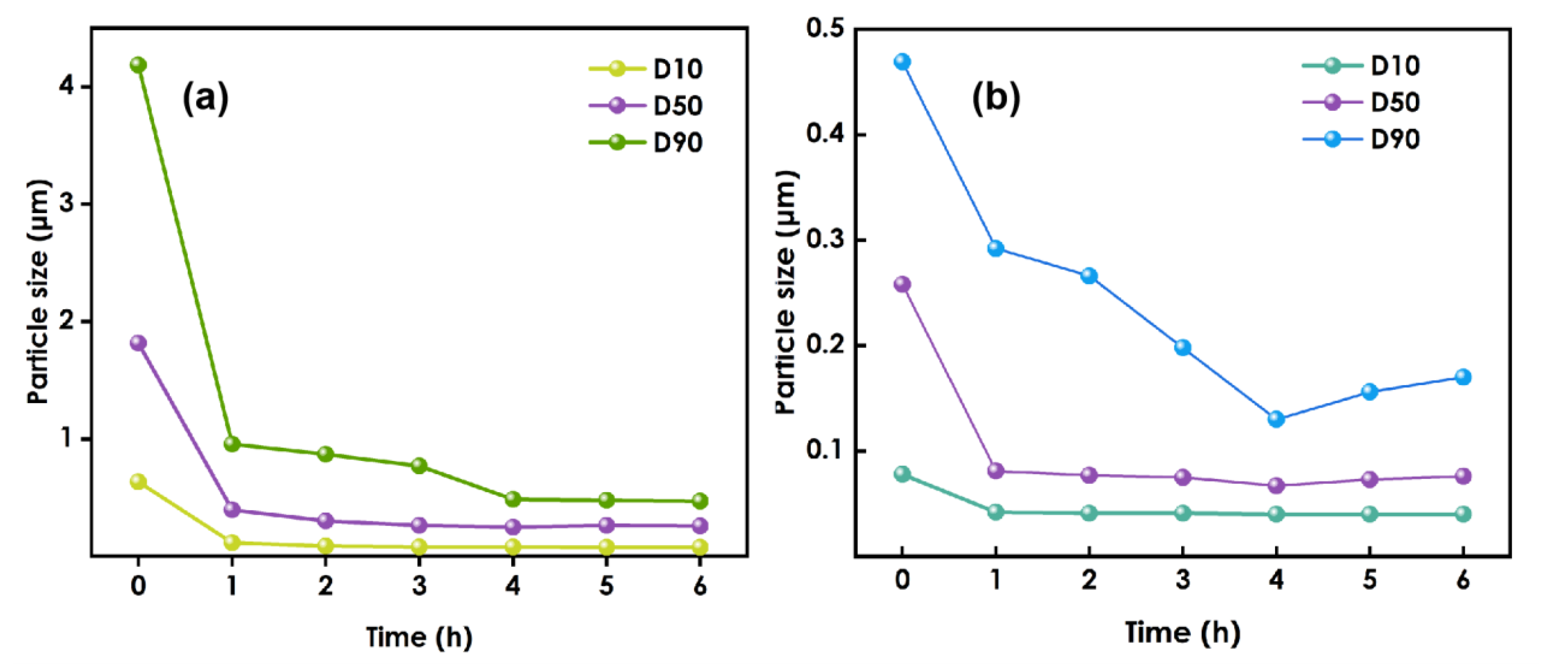
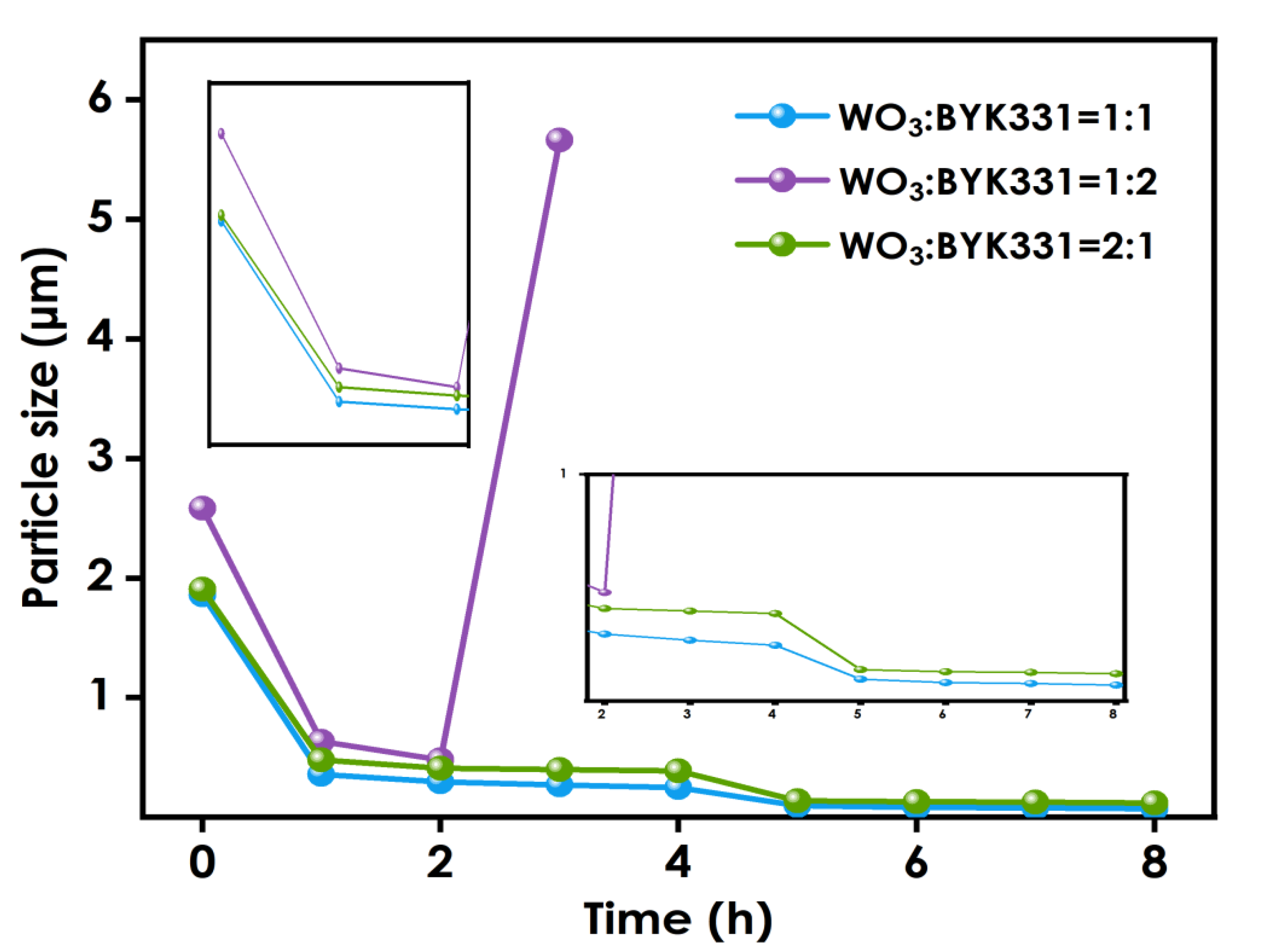
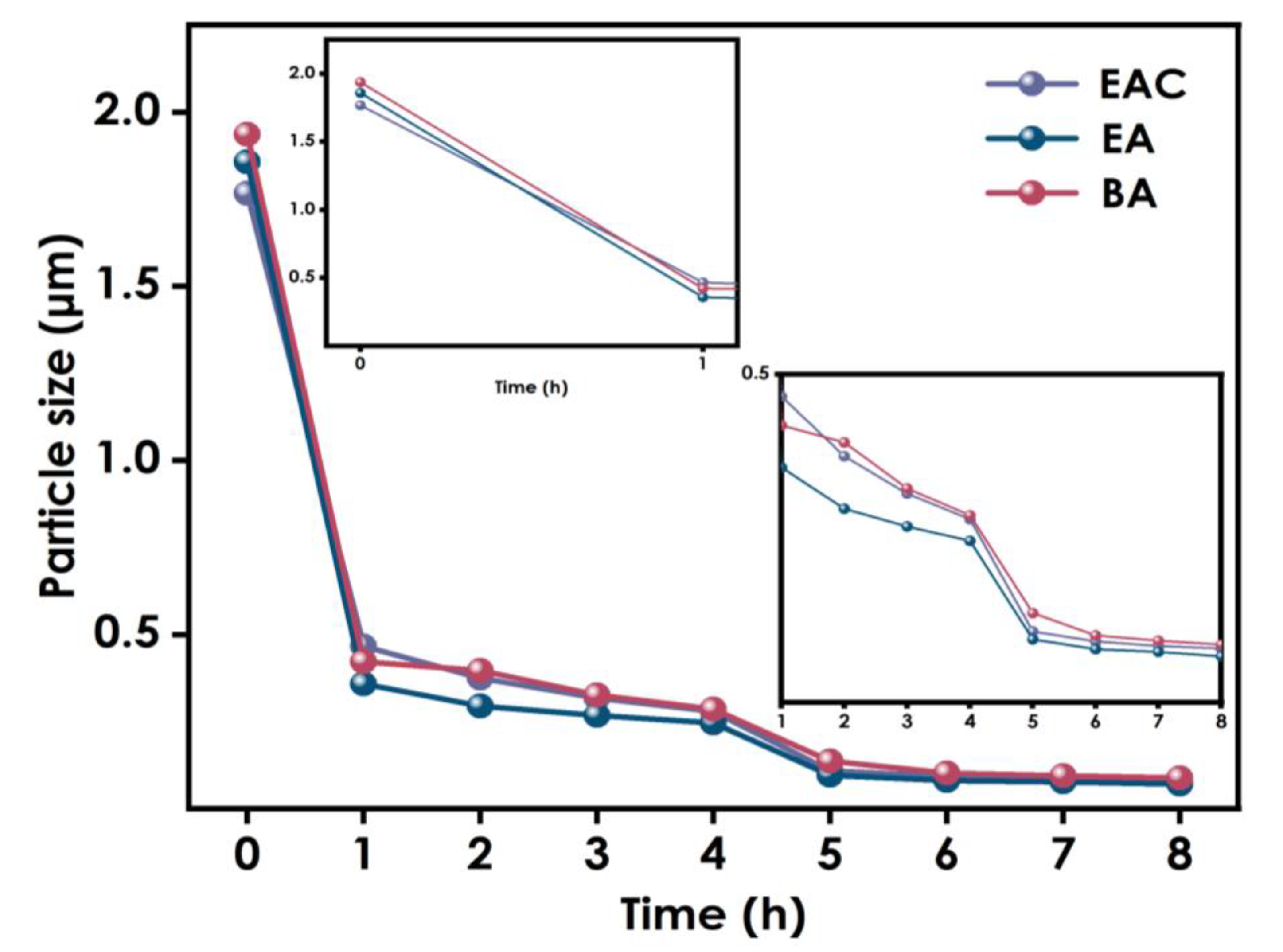


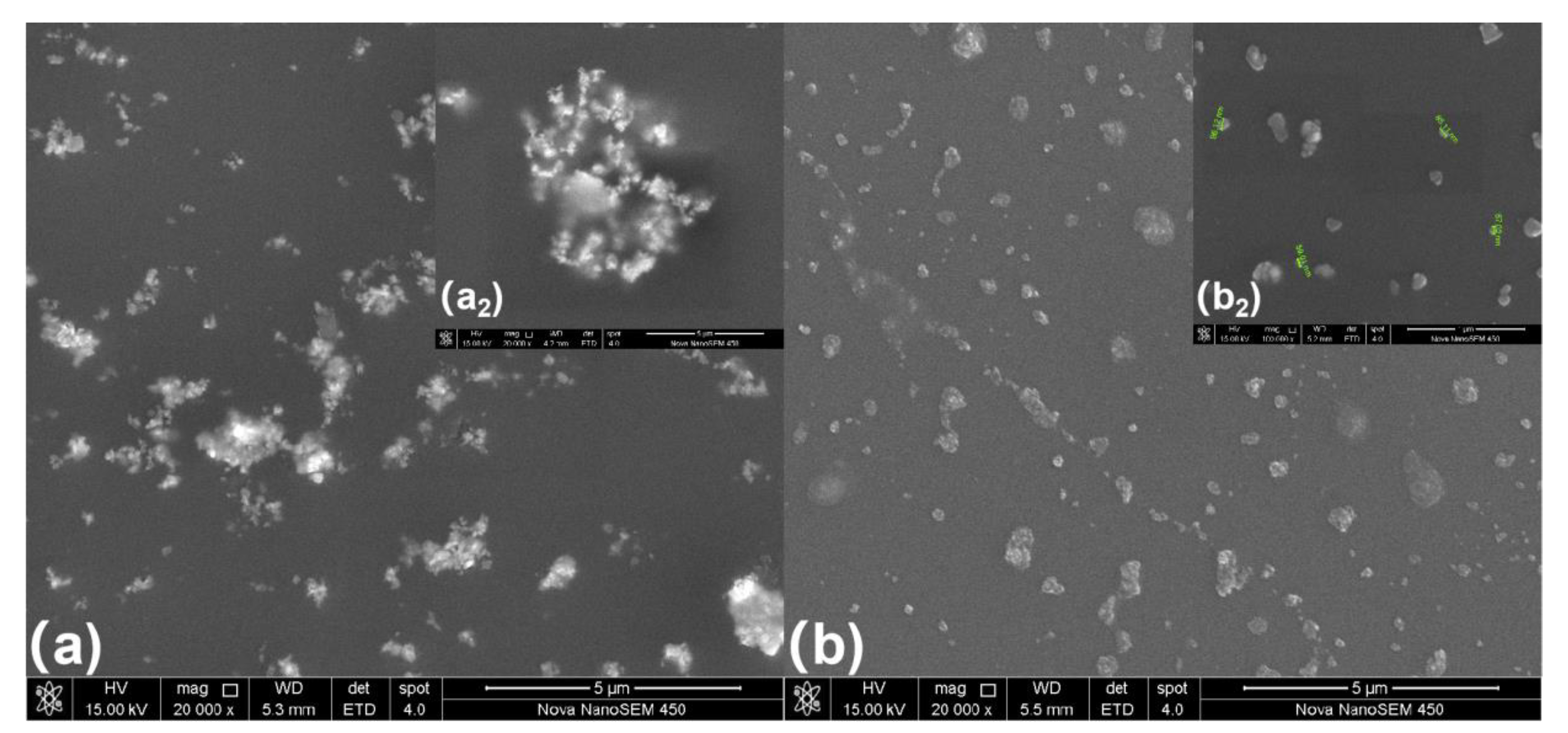
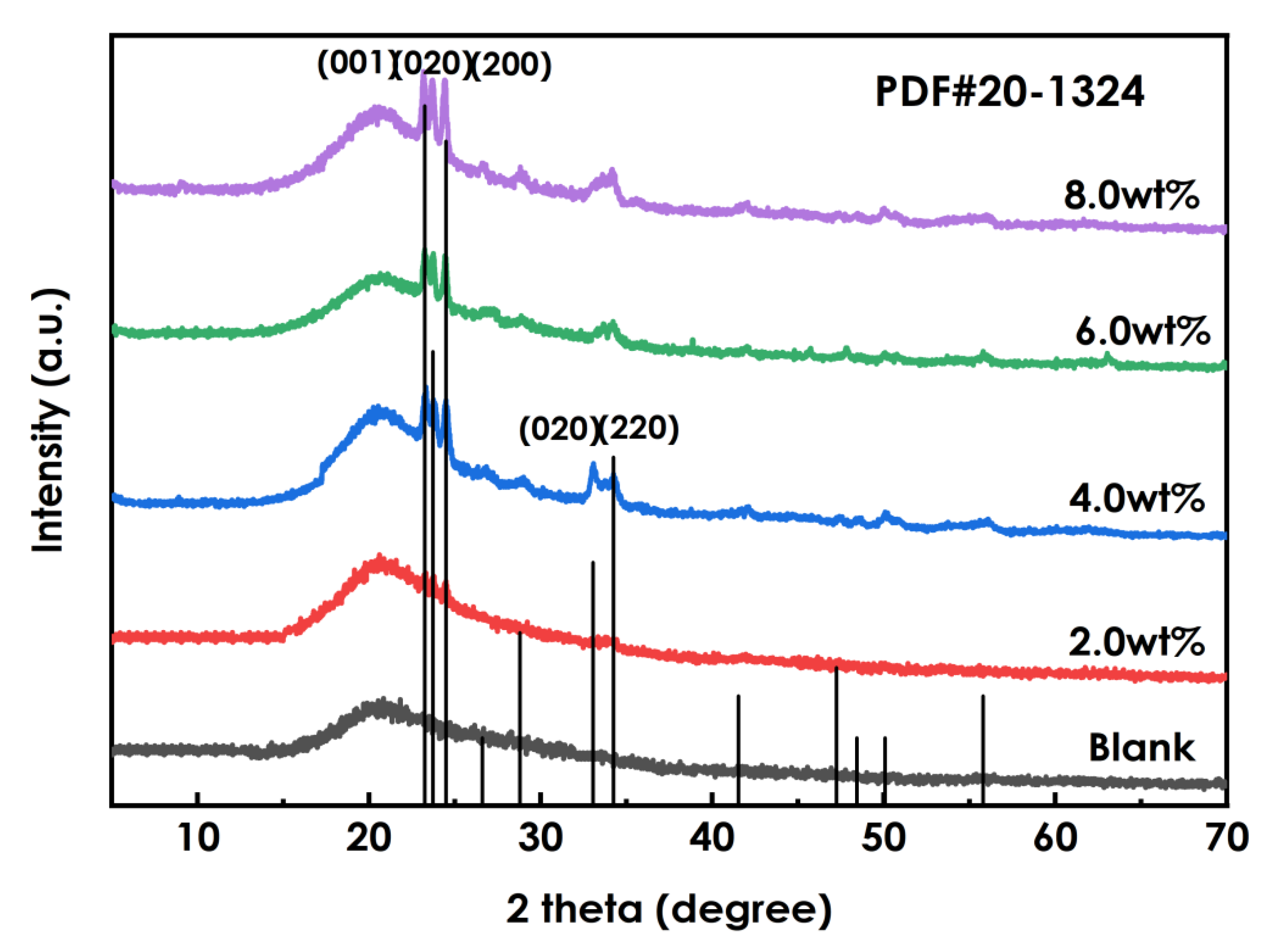

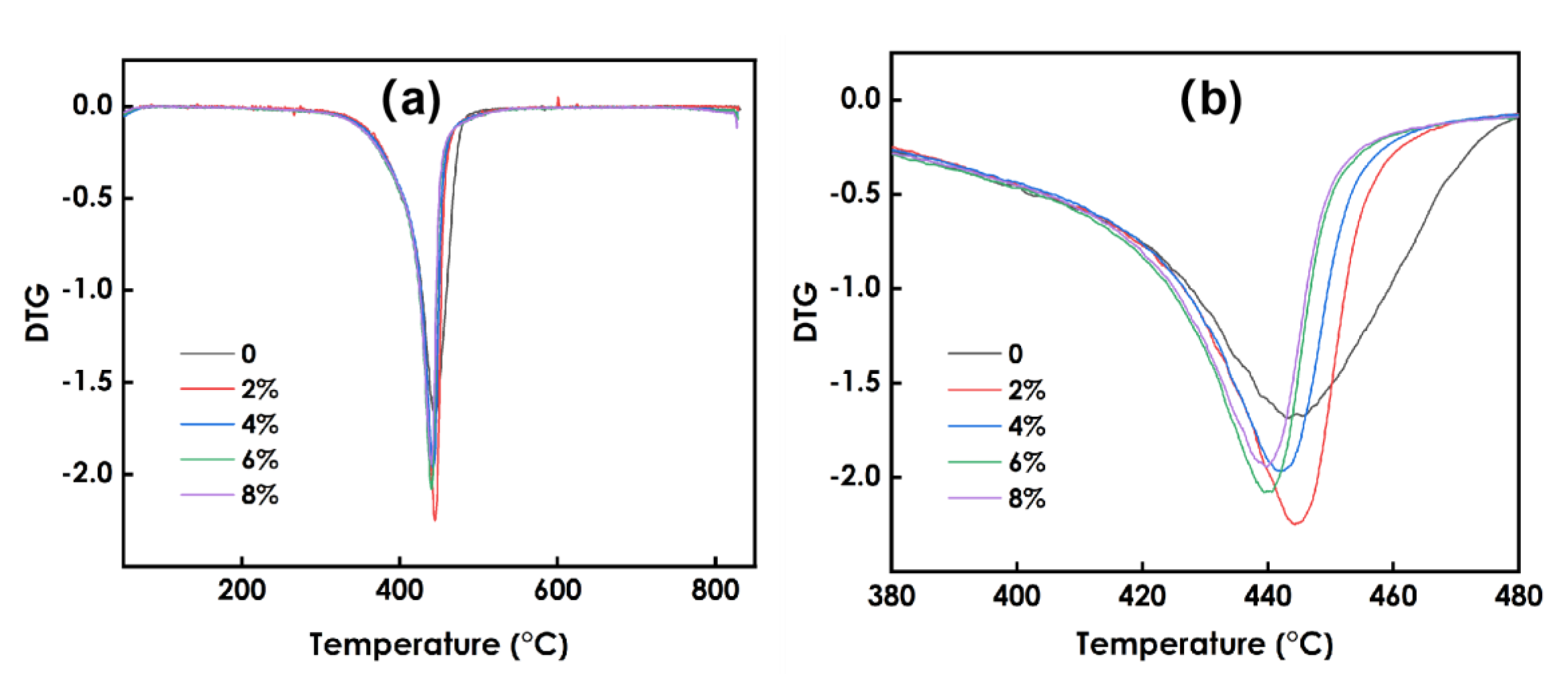

| 0 | 2% | 4% | 6% | 8% | |
|---|---|---|---|---|---|
| Haze | 0.2 | 0.8 | 1.2 | 1.8 | 2.6 |
| Hardness | HB | 2H | 2H | 2H | 3H |
| Adhesion | 5B | 5B | 4B | 3B | 0B |
Publisher’s Note: MDPI stays neutral with regard to jurisdictional claims in published maps and institutional affiliations. |
© 2022 by the authors. Licensee MDPI, Basel, Switzerland. This article is an open access article distributed under the terms and conditions of the Creative Commons Attribution (CC BY) license (https://creativecommons.org/licenses/by/4.0/).
Share and Cite
Wang, Z.; Zhong, R.; Lai, T.; Chen, T. Preparation of UV-Curable Nano-WO3Coating and Its Infrared Shielding Properties. Nanomaterials 2022, 12, 3920. https://doi.org/10.3390/nano12213920
Wang Z, Zhong R, Lai T, Chen T. Preparation of UV-Curable Nano-WO3Coating and Its Infrared Shielding Properties. Nanomaterials. 2022; 12(21):3920. https://doi.org/10.3390/nano12213920
Chicago/Turabian StyleWang, Zhengjie, Rong Zhong, Ting Lai, and Tianlei Chen. 2022. "Preparation of UV-Curable Nano-WO3Coating and Its Infrared Shielding Properties" Nanomaterials 12, no. 21: 3920. https://doi.org/10.3390/nano12213920
APA StyleWang, Z., Zhong, R., Lai, T., & Chen, T. (2022). Preparation of UV-Curable Nano-WO3Coating and Its Infrared Shielding Properties. Nanomaterials, 12(21), 3920. https://doi.org/10.3390/nano12213920





